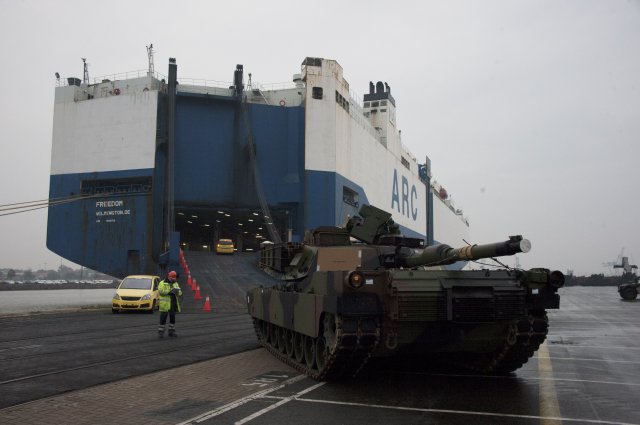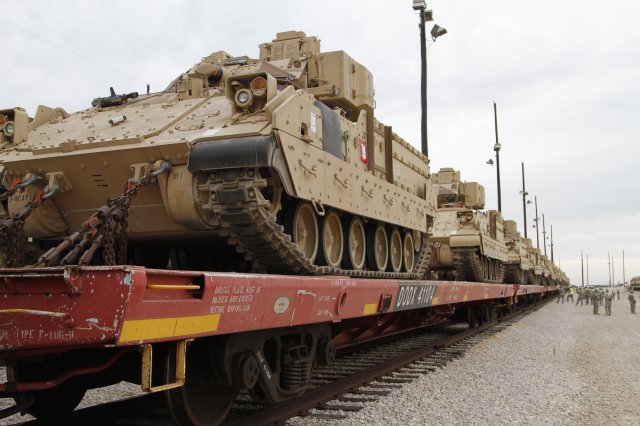
A US Army M1 tank about to be shipped out in an ARC ship for Trident Juncture wargames.
HUNTSVILLE, ALA: This morning, Army Chief of Staff Mark Milley warned Congress that “I have grave concerns” about the Army’s ability to respond to a major war — say, with Russia, Gen. Milley’s no. 1 threat — “in a timely manner.” Here in Huntsville, generals and executives explained a big part of the reason why.
“The environment’s changing and we have to be ready to go tonight,” said Lt. Gen. Gustave Perna, the chief supply officer (G-4) on the Army’s Pentagon staff. “We need to assume… that we will be contested wherever we go and that the enemy will not make the mistake of allowing us to go someplace close by and settle in and get ready.”
Predictable rotations to Afghanistan and Iraq for 15 years have left the Army painfully out of practice for rapid deployment to unexpected crises. Now the service must relearn those skills — even as budgets shrink, US-flagged shipping falls to historic lows, and adversaries like China and Russia invest in weapons to shoot us up as we come in.
Defense Secretary Ash Carter has directed Transportation Command to do a “strategic portfolio review” of “strategic mobility in a contested environment,” said the TRANSCOM deputy commander, Army Lt. Gen. Stephen Lyons. Currently, he said, “all of our campaign analysis that we do [assumes] that we’re going to operate with impunity. There’s no attrition [from enemy action] built into any of that.”
Lyons was on a panel this morning at the Association of the US Army winter conference, which identified three crucial problems for the Army’s ability to deploy:
- The rise of “anti-access/area denial” threats, the layered defenses of long-range sensors, missiles, aircraft, submarines, and more that China, Russia, and Iran have developed to keep US forces out.
- The atrophy of the Army’s ability to deploy on short notice without the kind of prep time, contractor support, and well-provisioned bases that we enjoyed in Afghanistan and Iraq.
- The decline of the Navy and US-flagged civilian cargo fleets.

Ships for the Army
You don’t expect to go to an Army event and hear generals angsting about ships, but that’s what happened this morning. Given the sheer weight of a modern armored force — vehicles and the fuel and ammunition they consume — most of that transport has to come by sea. But the Military Sealift Command fleet of government-operated vessels is aging, and the US-flagged commercial fleet is shrinking.
“The Military Sealift Command fleet will age out beginning really in about the mid-2020s,” said Lyons. “We’re getting with the Navy and Congress to come up with a strategy to recapitalize that fleet. We know we’re going to have to do that.”
The military always has to augment its in-house MSC fleet with US-flagged commercial cargo vessels. Transportation Command has authority to hire non-US-flagged ships to carry cargo, Lyons said when prodded, but “as a last resort.” While the general didn’t say so, there are not only political reasons for using US ships. If foreign ships refuse to enter an active war zone, there’s nothing the US government can do to make them complete delivery.
But there are only 78 US-flagged ships left in the international fleet, down from 120 a few years ago, said Eric Ebeling, CEO of American Roll-On-Roll-Off Carrier (ARC). (That’s distinct from the Jones Act fleet of US-flagged vessels that only travel from one US port to another).
“The US-flagged commercial fleet really exists to support the requirements of the Department of Defense,” said Ebeling bluntly. “But for military sealift requirements, there really is no compelling reason to operate ships under the US flag, because it certainly is not economically competitive.”

Bradley armored vehicles from the 1st Cavalry Division shipped out in August for a deployment to Eastern Europe.
Relearning The Basics
Even if you have the ships, you need to know how to load them — and that’s not a simple skill. A 70-ton M1 Abrams tank doesn’t fit into a standard shipping container. Artillery shells and Hellfire missiles require more careful handling than Ikea furniture.
Army units headed for Afghanistan and Iraq became accustomed to plenty of contractor support and plenty of lead time. Now the Army is trying to relearn how to deploy without either.
“Deployment operations are being added back onto the Mission Essential Task List [METL], so units have to train to execute deployment operations,” said Perna. At the direction of Chief of Staff Milley, exercises long conducted at the company level, or by the occasional battalion, are now being done by full brigades.
The Army is also throwing units some curveballs.
“Our most ambitious [deployment exercise] we’re doing is right now,” said Lt. Gen. Patrick Donahue, deputy commander of Army Forces Command. “We had a brigade of the 101st [Airborne Division] that thought they were going to JRTC [Joint Readiness Training Center in Louisiana] in April as they always do, with contracted line haul and contracted rail. Last week, we alerted them instead to deploy via sea.”
“So,” Donohue said with satisfaction, “they are shaking off all sorts of dust and knocking off all sorts of rust as they develop — rediscover … their ability to send their 800 vehicles and 200 containers, first by rail to Jacksonville, load ’em on a ship, sail ’em to Port Arthur, Texas, download them, and bring them to JRTC that way.”

Deploying More With Less
At the same time as the Army is relearning how to deploy, it’s also trying to streamline what it has to deploy.
“We’re very comfortable with mountains of repair parts,” Perna explained. “We’re very comfortable with service support from contractors. And when we get in that comfort zone, we make certain decisions about stockage levels: 50 days, 60 days, 90 days. If you’re in an expeditionary environment and you’re in contact [with an enemy], you’re not going to be able to develop those types of stockages.”
Today, Perna said, units need to stock what they need for the first days of an operation — “long enough for the supply chain to catch up.” They need to be able to carry it with them, on their own existing fleet of trucks, because “we’re not going to get any more.”
70-ton Abrams tanks with jet-fuel-guzzling turbine engines are not ideal for this kind of warfare. The total mass of entire armored brigade, from tanks to trucks, is simply staggering, as is the amount of gas it burns. “We must figure out a way to make it lighter,” said Perna. “We have to reduce the requirement for fuel…We have to figure out how to take less things with us.”
Ideally, future forces would be able to 3D-print spare parts on the battlefield, instead of having to stockpile or ship them. “It’s time that the Army seriously take the lead in additive manufacturing,” said Perna. “We need to embrace it so that we can shorten and reduce the supply chain.”
It’s especially important to loosen the Army’s logistical umbilical cord. Supply convoys were already a huge source of casualties in Afghanistan and Iraq, due to roadside bombs plus the occasional ambush. Russia, China, North Korea, and even Iran have arsenals of long-range missiles that could wreak havoc on US supply lines and staging bases. In a future conflict, we can’t assume they will let us deploy to a friendly county nearby, unload, get organized, and attack on our own schedule, the way Saddam Hussein did twice in 1991 and 2003.
Colin contributed to this story.
Army eyes TBI monitoring, wearable tech for soldiers in high-risk billets
“We are also looking at what additional personal protective equipment we can provide to our folks, especially instructors and others who are routinely exposed to blast pressure,” said Army Secretary Christine Wormuth.


























